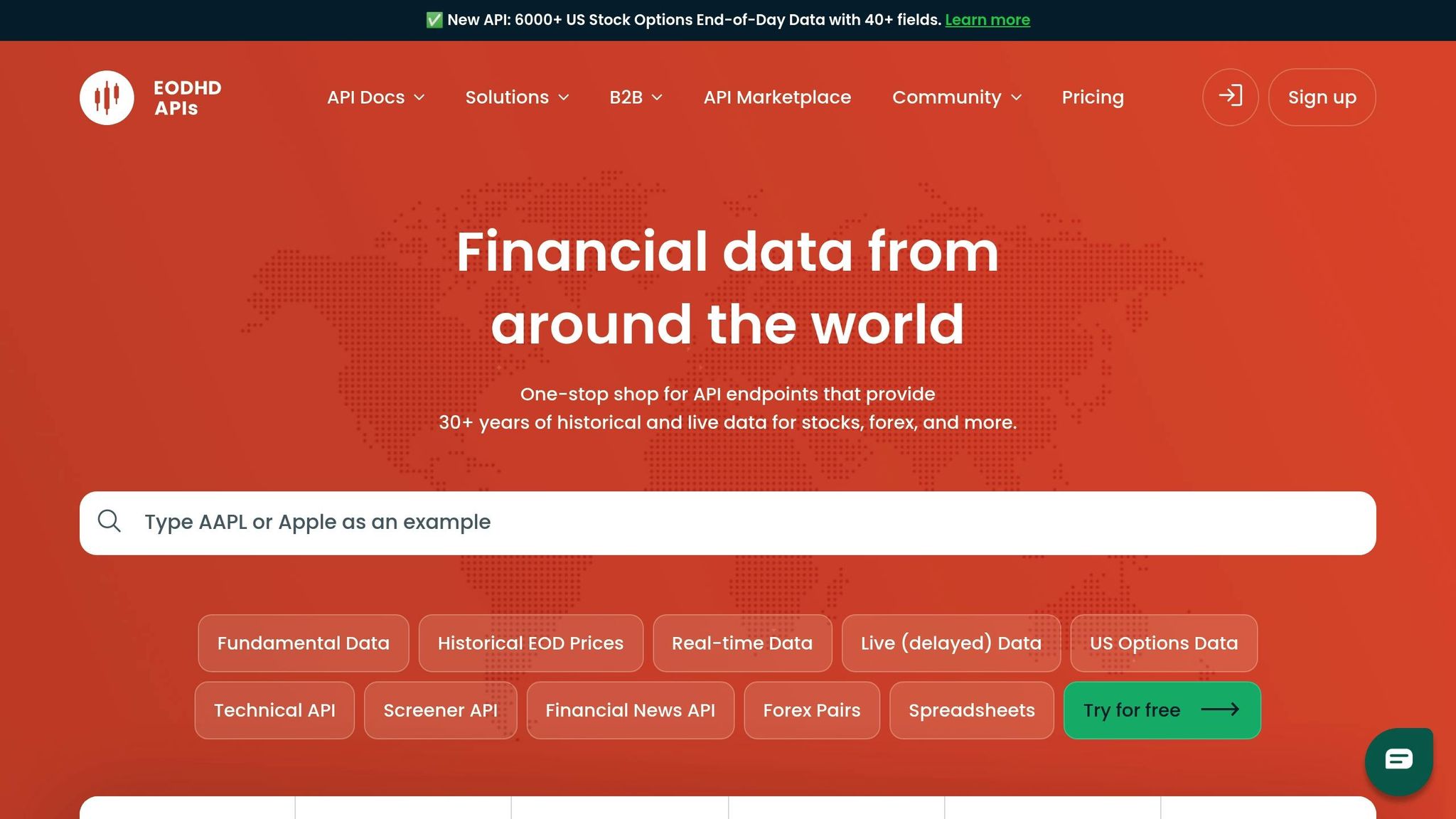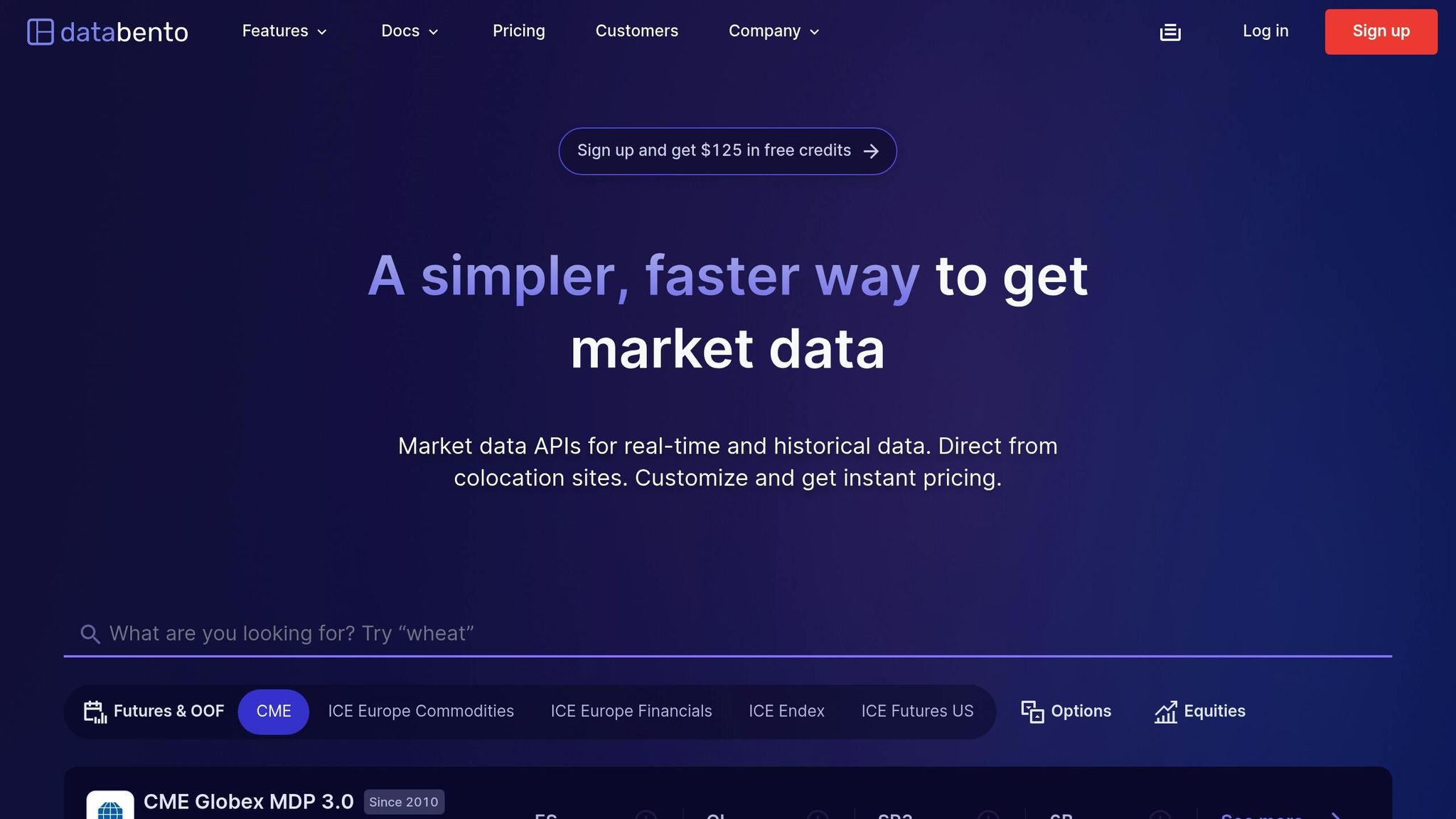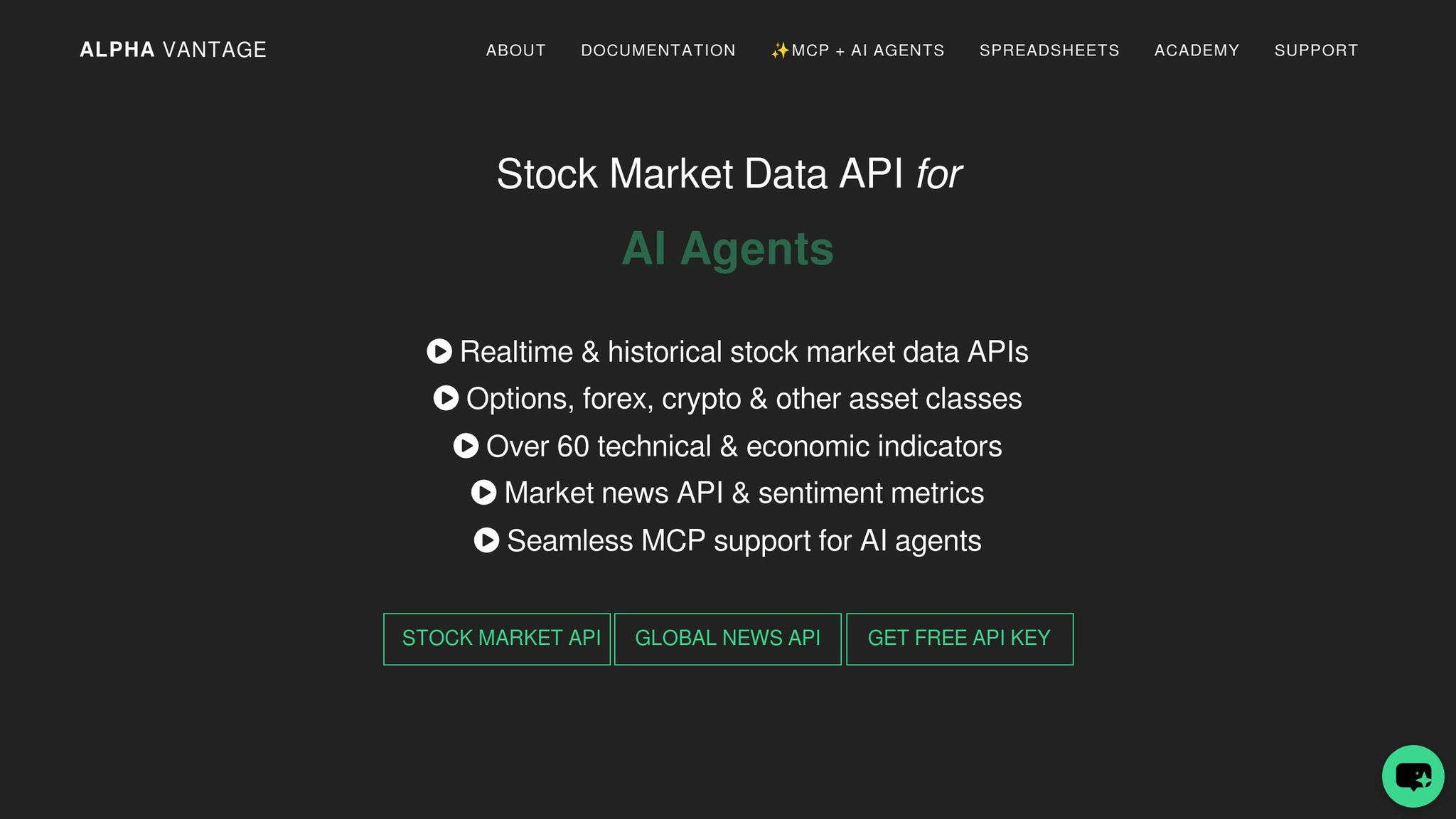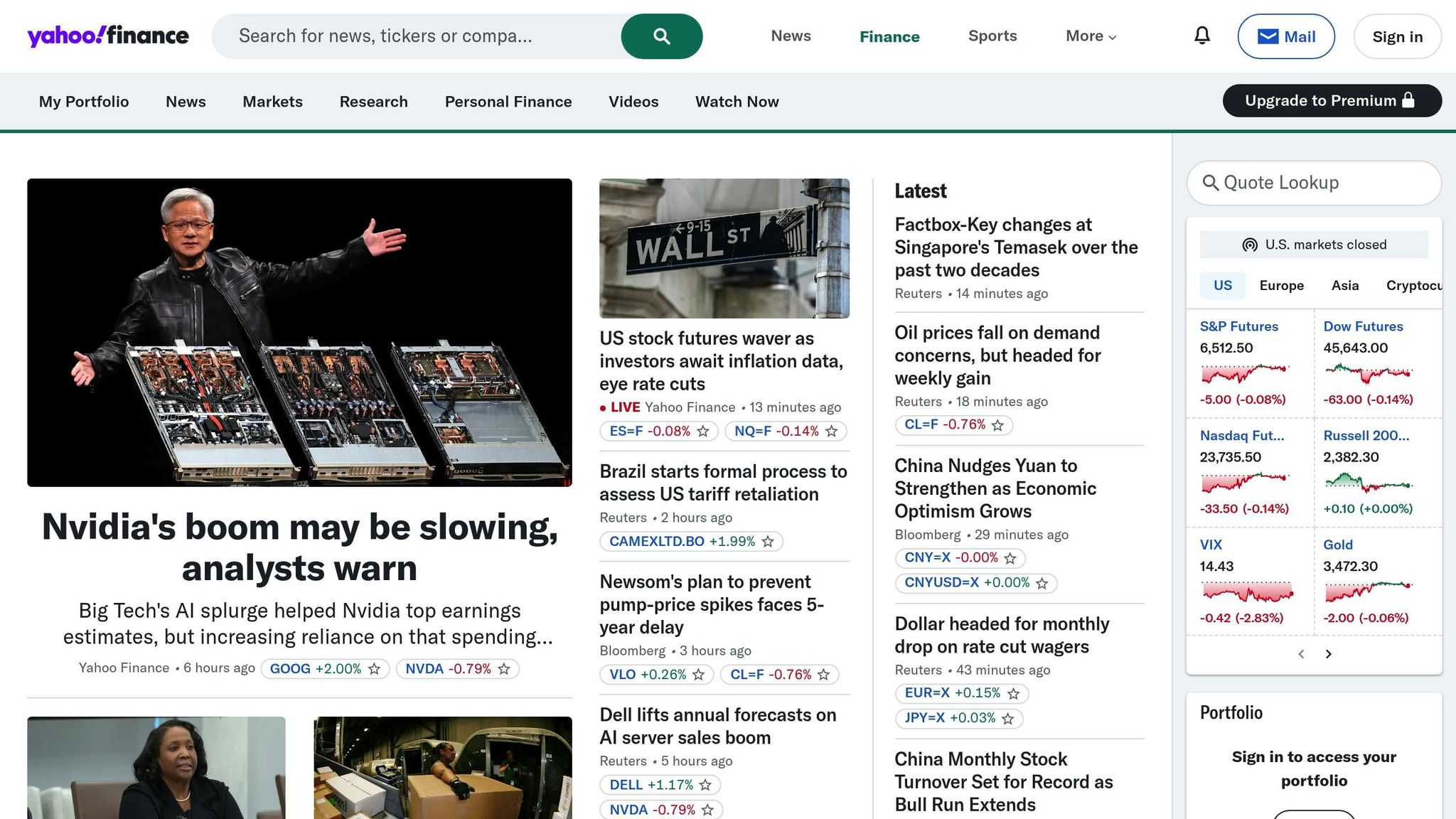In trading, having access to reliable historical options data is critical for backtesting strategies and analyzing market volatility. APIs simplify this process by delivering the data you need directly to your systems. Here’s a quick breakdown of the top options market data APIs:
- EOD Historical Data (EODHD): Offers 30+ years of global market data, including options, equities, and bonds. Provides metrics like Greeks, implied volatility, and technical indicators. Pricing starts at $99.99/month for personal use.
- Databento: Focused on high-frequency tick data and real-time options metrics. It’s developer-friendly and supports Python, C++, and Rust. Pricing is usage-based.
- Alpha Vantage: Great for general market data and technical indicators but has limited options metrics. Free tier available, with premium plans starting at $49.99/month.
- Yahoo Finance (Unofficial): Free options data via third-party Python libraries like
yfinance. Includes options chains and implied volatility but lacks official support, which may affect reliability.
Quick Comparison:
| Provider | Data Offered | Integration | Pricing |
|---|---|---|---|
| EOD Historical Data | Options, equities, bonds, Greeks | REST API, JSON format | $99.99/month (personal) |
| Databento | High-frequency options metrics | Python, C++, Rust SDKs | Usage-based pricing |
| Alpha Vantage | General market data, indicators | REST API | Free + $49.99/month |
| Yahoo Finance | Options chains, implied volatility | Python libraries | Free (unofficial) |
For professional-grade accuracy, go with EODHD or Databento. If you’re starting out or working on smaller projects, Alpha Vantage or Yahoo Finance may work just fine. Choose based on your trading needs and budget.
Comparing Options Data and APIs | Driven by Data Ep 47
1. EOD Historical Data (EODHD)

EOD Historical Data is an API provider that delivers data from over 70 global exchanges, with a historical archive spanning more than three decades. Below, we’ll break down its data coverage, key metrics, integration features, and pricing.
Data Coverage
EODHD offers options data for around 6,000 leading U.S. stocks, focusing on highly liquid contracts to reflect real market conditions. This extensive dataset allows users to study market volatility during major events such as the dot-com bubble and the 2008 financial crisis.
Beyond options, the platform also provides access to equities and bonds, making it a valuable resource for building multi-asset volatility models or exploring how different market segments interact.
Available Metrics
The options data feed includes critical metrics such as bid and ask prices, Greeks (delta, gamma, theta, vega), implied volatility, and detailed contract specifications. These daily updates are essential for tasks like calculating volatility surfaces, analyzing time decay, and crafting risk management models.
For those looking to expand their analysis, EODHD also offers technical indicators and stock screening tools through its extended packages. These features provide deeper insights into stock movements, while fundamental data feeds help traders consider broader market factors that might influence volatility.
Integration & Developer Support
Integration is straightforward, thanks to the API’s use of standard REST protocols. Paid plans allow up to 1,000 requests per minute, ensuring sufficient capacity for backtesting and data analysis. The platform provides thorough documentation and consistent data formatting, making it easier to integrate data across various asset classes.
Support options depend on the subscription level. Personal plans include standard email and web chat support, while commercial plans offer enhanced assistance. Businesses on custom plans can even access a dedicated account manager for tailored support.
Pricing
EOD Historical Data uses a tiered pricing model to accommodate both individual and commercial users.
- Personal Use: The ALL-IN-ONE Package costs $99.99 per month (or $83.33 per month with an annual commitment). This includes historical EOD data, fundamentals, real-time feeds, and technical indicators. Adding the US Stock Options Data API costs an extra $29.99 per month, bringing the total to roughly $130 for personal users.
- Commercial Use: The All-In-One for Business plan costs $299.00 per month (or $249.17 with annual billing). This plan includes internal data redistribution rights and priority support. Custom enterprise solutions are also available, offering higher API limits and expanded redistribution rights through direct consultation.
For students, EODHD offers a generous 50% discount for educational purposes. A free tier is also available, allowing users to test and evaluate the platform before committing.
2. Databento

Databento simplifies how developers access market data by offering dedicated tools and resources for integration. It provides official client libraries for Python, C++, and Rust, making it easier to incorporate market data into applications while minimizing code complexity and following best practices.
The platform’s detailed documentation covers everything developers need – API endpoints, data schemas, and practical code examples – to ensure smooth and efficient data retrieval. Plus, its multi-channel customer support is there to assist with setup and troubleshoot any issues that might arise.
These integration tools and support services lay a strong foundation for diving deeper into the advanced features of its APIs.
3. Alpha Vantage

Alpha Vantage is a well-known provider of financial data, offering a range of REST APIs. While it stands out for general market data and technical indicators, its options metrics are somewhat limited, making it less ideal for in-depth options volatility analysis.
Data Coverage
The API provides historical market data for a wide array of equities, forex, cryptocurrencies, and other asset classes. This extensive coverage supports the technical indicators it offers, which are detailed below.
Available Metrics
Alpha Vantage delivers a variety of technical indicators to assist with market analysis. These include tools like Bollinger Bands, RSI, and MACD. The API supports intraday data with intervals ranging from minutes to daily, making it a useful resource for backtesting strategies.
Integration & Developer Support
Integration is straightforward thanks to well-documented endpoints and consistent JSON responses. Developers can find code examples in multiple languages, such as Python, JavaScript, and R. The API relies on simple HTTP GET requests with API key authentication, making the setup process quick and easy.
These developer-friendly features are paired with a flexible pricing structure.
Pricing
Alpha Vantage uses a freemium pricing model designed for both individual traders and developers. The free tier includes core features with standard rate limits, while premium plans offer higher API call limits and additional capabilities. Check the official website for the latest pricing details.
4. Yahoo Finance API

Even though Yahoo Finance officially discontinued its API back in 2017, it’s still possible to access its data through unofficial methods, making it a go-to resource for quantitative traders.
Data Coverage
Yahoo Finance provides a wealth of historical market data, including information on equities, options, dividends, and stock splits. For options traders, it offers options chains and key metrics like implied volatility. This rich dataset has made it a favorite for those building and backtesting trading strategies.
Available Metrics
In addition to its broad data coverage, Yahoo Finance delivers crucial metrics for options analysis. Traders can access historical options prices, implied volatility figures, and detailed options chain data, such as strike prices, expiration dates, and open interest. The platform also includes fundamental data and technical indicators. Tools like the yfinance and yahoo_fin libraries simplify the process, providing functions to pull stock lists and other data with ease.
Integration & Developer Support
Using Yahoo Finance data is relatively simple, thanks to unofficial Python libraries. For instance, yfinance can be set up with just a few lines of code. It automatically formats the retrieved data into pandas DataFrames, making it ready for analysis. Whether you’re looking to fetch historical prices or options data, all it takes is creating a ticker object and calling its methods. However, keep in mind that these libraries rely on direct API calls and web scraping. This means they’re vulnerable to website layout changes and may encounter rate limits, which could disrupt workflows.
Pricing
Unofficial methods like yfinance and yahoo_fin are both free and open-source, making them highly appealing. Alternatively, RapidAPI offers a tiered pricing model, with a free plan that allows up to 500 requests per month. While the zero-cost options are attractive, relying on these unofficial solutions comes with risks, particularly for critical systems where data reliability is non-negotiable.
API Comparison: Pros and Cons
When it comes to historical options data and volatility metrics, each API provider has its strengths and drawbacks. Your choice will depend on your specific requirements and budget. Here’s a breakdown of what each provider offers.
EOD Historical Data is known for its high-quality and consistent data, making it a top choice for institutional and quantitative trading applications. However, this level of quality comes with a higher price tag, which might not work for individual developers or smaller trading setups.
Databento stands out for its detailed data granularity and low-latency access, which are crucial for precise analysis. Its modern infrastructure and developer-friendly tools make integration a breeze. That said, its pricing structure can be steep, making it less accessible for beginners or casual users.
Alpha Vantage strikes a balance by offering broad data coverage at affordable pricing tiers. However, its historical data depth is limited compared to more premium providers, and rate restrictions can hinder workflows that require intensive data analysis.
Yahoo Finance API remains a go-to for many due to its zero cost and ease of use, especially with Python libraries. The downside? It’s not officially supported, leading to reliability concerns and occasional service disruptions.
Here’s a quick comparison of their key features:
| API Provider | Data Coverage | Available Metrics | Integration | Pricing |
|---|---|---|---|---|
| EOD Historical Data | Comprehensive global coverage, 20+ years of historical data | Full options chains, IV, Greeks, dividends, splits | RESTful API, multiple formats | Starting at $19.99/month |
| Databento | High-frequency tick data, extensive US markets | Real-time and historical IV, volume, OI | Modern APIs, Python SDK | Usage-based, premium pricing |
| Alpha Vantage | Good US coverage, limited international | Basic options data, IV, technical indicators | Simple REST API, JSON format | Free tier + $49.99/month plans |
| Yahoo Finance | Broad market coverage, decent history | Options chains, basic IV, fundamental data | Unofficial Python libraries | Free (unofficial methods) |
Professional trading firms often favor EOD Historical Data or Databento for their reliability and extensive datasets. Meanwhile, individual developers and researchers might find Alpha Vantage a practical choice for backtesting. For hobbyist traders and students, Yahoo Finance offers a no-cost entry point, though its reliability issues make it less suitable for critical projects.
Ultimately, the right API depends on your needs. For mission-critical applications where accuracy is non-negotiable, investing in a premium service is worth it. On the other hand, if you’re experimenting or learning, free or budget-friendly options can meet your needs without breaking the bank.
Conclusion
Choosing the right API comes down to understanding your specific requirements and matching them with what each provider brings to the table. For institutional traders needing broad market coverage, EOD Historical Data offers extensive data solutions. If your strategies rely on high-frequency, detailed data, Databento provides a modern infrastructure tailored for advanced use cases. Meanwhile, Alpha Vantage caters well to individual developers and researchers, and Yahoo Finance remains a solid choice for educational projects or early-stage prototyping.
APIs are the backbone of effective options trading, offering critical metrics like bid/ask quotes, Greeks, theoretical prices, volume, open interest, and implied volatility. These data points are essential for crafting sophisticated trading models and uncovering profitable opportunities. However, having quality data is only part of the equation – successful trading also demands precise and efficient data processing.
This is where QuantVPS steps in. Its ultra-low latency and 24/7 operational environment allow your algorithms to process data and execute trades in real time. Whether your strategy hinges on real-time volatility calculations or rapid pricing adjustments, integrating your API with QuantVPS ensures your execution environment can keep pace, translating into more effective and practical strategy implementation.
FAQs
What should I look for in an API for historical options data and volatility analysis?
When choosing an API for historical options market data and volatility analysis, start by evaluating its data coverage. Look into how extensive the historical records are and whether a wide range of market instruments is included. The accuracy and reliability of the data are equally critical, as your analysis depends heavily on these factors.
You’ll also want to weigh other considerations like cost, how easily the API integrates into your systems, and whether it supports common formats like JSON to simplify implementation. APIs with low latency and built-in analytical tools can be especially useful for tasks like backtesting and developing strategies. Ultimately, focus on finding a solution that fits your specific trading or research goals to get the best results.
How does the cost of these APIs impact their suitability for individual traders and professional firms?
The cost of APIs for historical options market data and volatility can greatly influence their appeal to different types of users.
For individual traders, lower-cost or even free plans often do the trick. These plans typically offer enough data for basic analysis and backtesting, making them a solid choice for smaller projects or personal trading strategies.
In contrast, professional firms usually need much more robust data solutions. They often rely on real-time and high-frequency updates to power advanced trading strategies. These features are available in higher-priced subscription tiers, which deliver the precision and depth required for enterprise-level operations. With this tiered pricing structure, users can choose a plan that fits both their specific needs and their budget.
What are the risks of relying on unofficial APIs like Yahoo Finance for trading applications?
Relying on unofficial APIs like Yahoo Finance for critical trading applications comes with several risks. These include data inaccuracies, security vulnerabilities, and instability stemming from unverified or inconsistent data sources. Since these APIs aren’t officially supported or regulated, they can be unreliable and might even stop working without warning.
These risks could result in financial losses, legal complications, and difficulties in meeting industry compliance requirements. For professional trading or backtesting, it’s essential to stick with trusted, well-documented APIs that prioritize data accuracy and provide long-term reliability.








